Compliance-driven operations management for safety-focused businesses, but lacks auto-scheduling and real-time GPS tracking
Verdict: 7/10
Jolt is an operations management tool that excels at compliance and safety protocols. I found the software shines in areas like automated temperature monitoring, digital checklists, and labeling systems, making it particularly effective for food service operations and businesses with strict safety requirements.
Jolt does support multi-location management, but switching between locations isn’t as seamless as it could be. Users must manually toggle between locations, which can slow things down for businesses managing multiple sites in real time.
I also noticed there’s no auto-scheduling, which could be a deal-breaker for businesses looking to build schedules with a click. It also lacks some advanced GPS features for managing field staff.
Key Features:
- Digital checklists: Create and manage comprehensive operational checklists with real-time completion tracking and accountability.
- Time clock: Have workers track time with facial recognition and QR code options.
- Task management: Assign and track daily tasks with completion verification and photo documentation.
- Employee scheduling: Basic scheduling capabilities with shift management and time-off requests.
- Team communication: Built-in messaging and announcement features for staff updates and operational communications.
- Document library: Central repository for storing and accessing operational documents and procedures.
- Compliance tracking: Monitor and document food safety compliance with automated logging and reporting.
- Temperature sensors: Automated temperature monitoring and logging for food safety compliance with instant alerts for violations.
- Label printing: Generate custom food prep and expiration labels with automated calculations and compliance information.
- Information library: Central hub for storing and distributing documents, videos, and policies.
Pros
- Extensive checklist features
- Exceptional compliance and safety monitoring features
- Labeling system with automation
- Reliable temperature monitoring with alerts
Cons
- Higher price point
- No auto-scheduling functionality
- Restricted geofencing options
- No real-time GPS tracking
Jolt Pricing
Jolt pricing isn’t listed on its website—you’ll find only hardware prices there.
After experiencing an impressively thorough demo with Jolt’s sales team, I received a tailored pricing proposal based on my selected features: checklists, time clock, scheduling, and communication modules.
For a single location, the standard pricing is $296.79 per month with a $549 setup fee. However, I was offered a negotiated package with substantial discounts:
- Single location: $207.75/month (30% off standard rate)
- 4 locations: $664.80/month total ($166.20/location)
- Annual payment for 4 locations: $7,179.84/year ($598.32/month equivalent)
- Setup fee waived ($549 value)
The package includes unlimited users per location, full onboarding, and 24/7 support. Hardware—like temperature sensors, label printers, and tablets—is sold separately through Jolt’s self-service portal.
One thing I appreciated? There are no charges until the platform is fully implemented, and pricing remains locked in for 2-3 years.
Jolt’s pricing varies based on the number of locations and selected features. While I opted for the core software suite, businesses with different needs may see different pricing structures.
Discounts scale with larger deployments—companies with 10+ locations can expect further price reductions, potentially up to 45-50% off standard rates.
Even with these discounts, Jolt sits at the premium end of the market, with pricing higher than competitors like 7shifts, HotSchedules, and Connecteam.
| Team Size | Jolt [unlimited users/month/location] | 7shifts (The Works) [unlimited users/month/location] | Homebase (Plus) [unlimited users/month/location] | Connecteam (Advanced) |
| View pricing | View pricing | View pricing | View pricing | |
| 10 Users | $207.75 | $69.99 | $48 | Free |
| 20 Users | $207.75 | $69.99 | $48 | $49.00 |
| 30 Users | $207.75 | $69.99 | $48 | $49.00 |
| 50 Users | $207.75 | $69.99 | $48 | $79.00 |
| Read our in-depth 7shifts review. | Read our in-depth Homebase review. | Learn more about Connecteam | ||
| Monthly cost when billed annually, as of March 2025. | ||||
Verdict: 5/10
Jolt Usability and Interface
Jolt doesn’t offer a free trial, so I signed up for the demo, where a representative walked me through the core features.
I found that Jolt’s interface prioritizes function over style. The web interface sports a traditional layout with a vertical navigation bar on the left for core functions like people management, account settings, and support resources. While it’s not winning any design awards, it gets the job done.
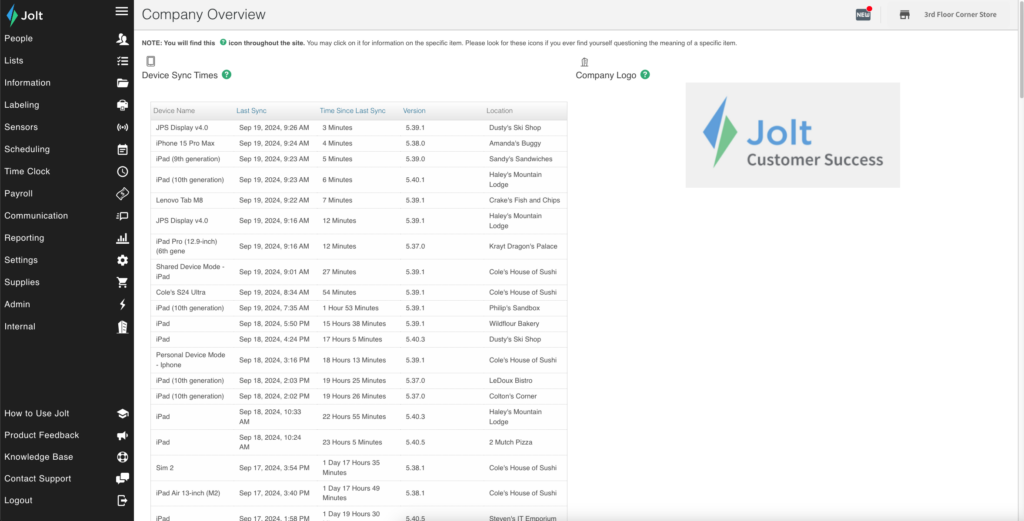
The top horizontal bar hosts some useful features, including a location switcher for multi-site businesses and a toggle between content group and location modes. This dual-mode system caught my interest: Content group mode lets you standardize operations across locations, while location mode enables site-specific customization.
The catch? Switching between these modes isn’t as intuitive as I’d like. The process involves multiple steps—logging in, navigating to the dropdown menu, selecting the mode, and saving changes. This multi-step process might not be straightforward or quick for all users, especially if they’re frequently toggling between modes.
Navigation takes some getting used to. Once you understand how different sections connect, it makes sense, but new users might need time to adjust.
That said, I found the “Roles and Permissions” interface well thought out, with clear distinctions between location roles and content group roles.
When it comes to accessibility, Jolt offers basic features like text scaling and contrast options, but it’s missing the more sophisticated accessibility tools I’ve seen in modern enterprise software—such as screen reader support, keyboard navigation enhancements, customizable color schemes, and voice command functionalities.
Verdict: 6/10
Mobile app
During the demo, the representative walked me through how things look on the employee’s end using an iPad. Like the web portal, the mobile app focuses more on getting things done than looking pretty. The app uses a vertical sidebar with clear icons for essential features: Home, Lists, Library, Logbooks, Labels, Sensors, Reports, People, Tools, Settings, and the Jolt logo.
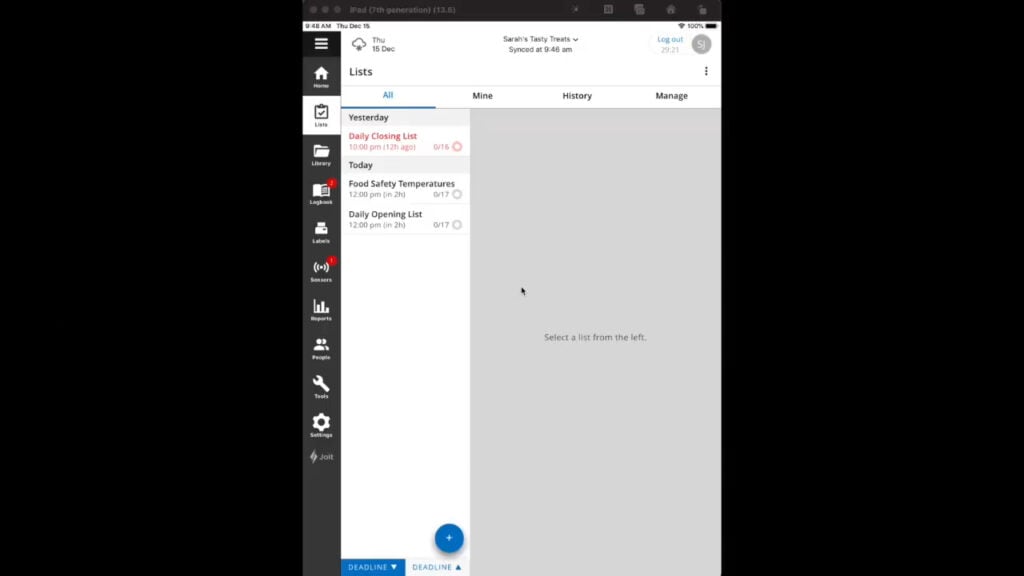
Organization is one of the app’s strong points. Take the Lists module—it smartly divides tasks into “All,” “Mine,” “History,” and “Manage” tabs, making it easy to find assignments.
I also liked the app’s dual operation modes: Single-User Device mode for individual employees and Multi-User Device mode for shared tablets. With the latter mode, a restaurant could require workers to clock in and out through a shared iPad using unique PIN codes—which is great for preventing time theft.
Unfortunately, switching between locations feels clunky on the mobile app, too—you must also do it manually. Some competing apps use GPS or other location services to automatically detect and switch the user’s interface to match their physical location.
A feature that impressed me was the offline functionality. The app keeps working without the internet, syncing everything once you’re back online.
Push notifications work fine in Single-User mode but aren’t available for shared devices, which could present communication issues in busy environments where teams use single shared devices only.
Verdict: 8/10
| Feature | Admin | Employee | ||
| Web | Mobile | Web | Mobile | |
| Core features | ||||
| Time Clock | ✅ | ✅ | ✅ | ✅ |
| Lists | ✅ | ✅ | ✅ | ✅ |
| Schedule | ✅ | ✅ | View Only | View Only |
| Message Blasts | ✅ | ✅ | ❌ | ❌ |
| Announcements | ✅ | View Only | View Only | View Only |
| Document Library | ✅ | View Only | View Only | View Only |
| Time Off Requests | ✅ | ✅ | Submit | Submit |
| Analytics features | ||||
| Dashboards | ✅ | Limited | ❌ | ❌ |
| Reports | ✅ | View Only | ❌ | ❌ |
| Compliance Tracking | ✅ | Limited | ❌ | ❌ |
| Labor Cost Analysis | ✅ | ❌ | ❌ | ❌ |
| Management functions | ||||
| User Management | ✅ | Limited | ❌ | ❌ |
| Role Configuration | ✅ | ❌ | ❌ | ❌ |
| Location Settings | ✅ | Limited | ❌ | ❌ |
| Device Management | ✅ | Limited | ❌ | ❌ |
| Shift Approvals | ✅ | ✅ | ❌ | ❌ |
| Audit Logs | ✅ | View Only | ❌ | ❌ |
Jolt Core Functionalities
Jolt offers a comprehensive suite of hardware and software solutions to streamline business operations. Below, I focus on core software features.
Checklists and task management
Jolt’s checklist system is its flagship feature, and after my demo, I see why. It’s not just about ticking off tasks—it’s a full system built to handle real-world operations, especially in industries like food service, construction, and retail.
Checklists are created in the web portal and sync to the mobile app, making it easy for teams to follow structured workflows.
What impressed me most was the flexibility. Instead of having staff tick off basic checkboxes only, you can require photo proof, QR code scans, signatures, or even temperature readings. That’s great for compliance-focused businesses that need proof tasks were done right.
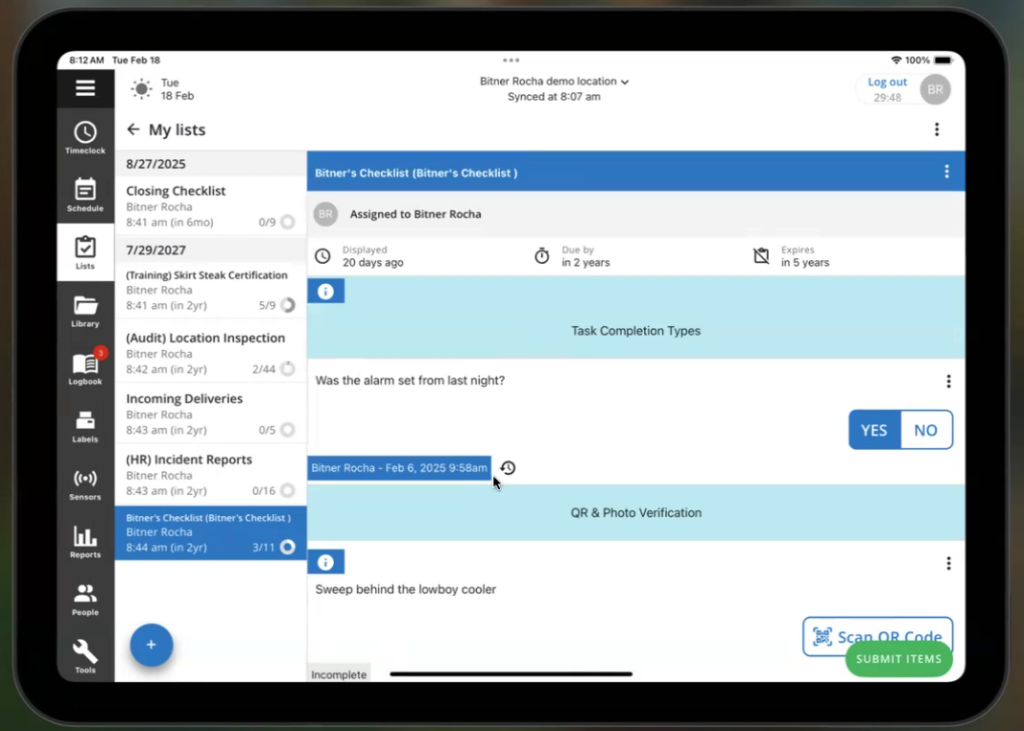
The way Jolt handles assignments is smart. In addition to assigning tasks to specific people, you assign them to roles. That means if someone calls out sick, the task still gets done without managers having to scramble. Plus, managers get alerts for overdue tasks, out-of-range measurements, or incomplete checklists, so nothing slips through the cracks.
I appreciate how employee training is built into checklists. You can add videos and quizzes right into tasks, letting employees watch training materials and answer questions before marking a task complete. The system tracks who’s watched the videos, when they completed them, and which scores they got.
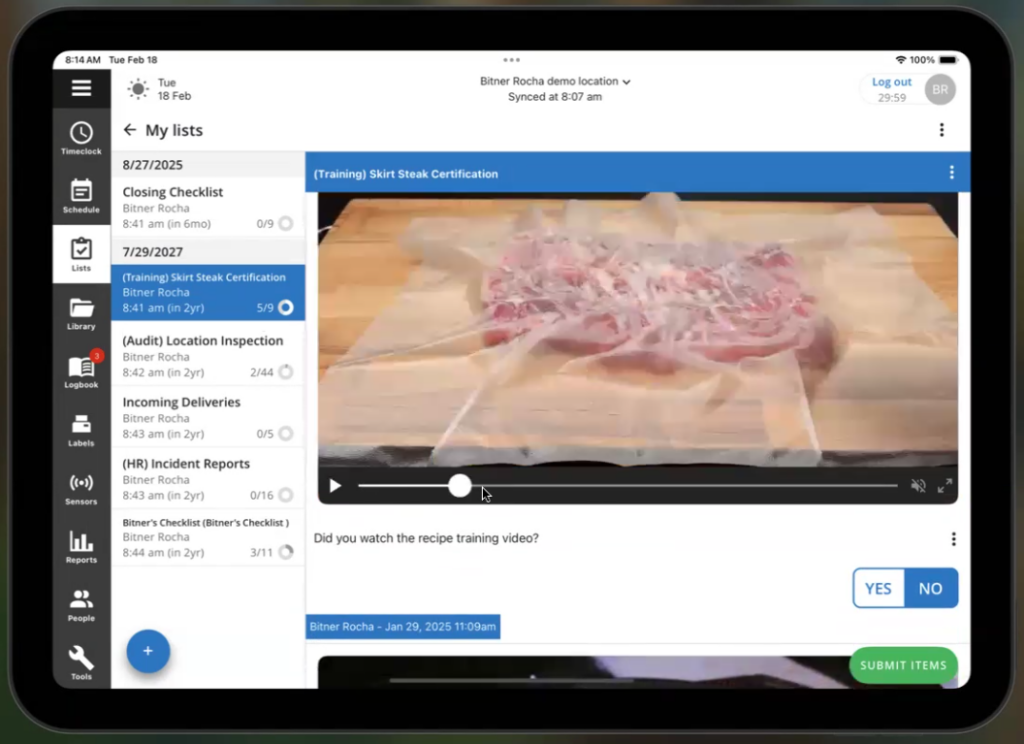
Jolt also offers geofencing for checklists, ensuring that employees can complete lists within defined locations only. However, it works exclusively on single-user devices and doesn’t support shared devices. This could pose issues: For instance, if a construction crew is working team-wide checklists using a shared device, you can’t ensure lists are getting completed where they should be.
Also, Jolt’s geofencing feature is limited to lists only. This differs from time tracking apps like Connecteam, which use geofencing to restrict clock-ins and clock-outs to designated areas.
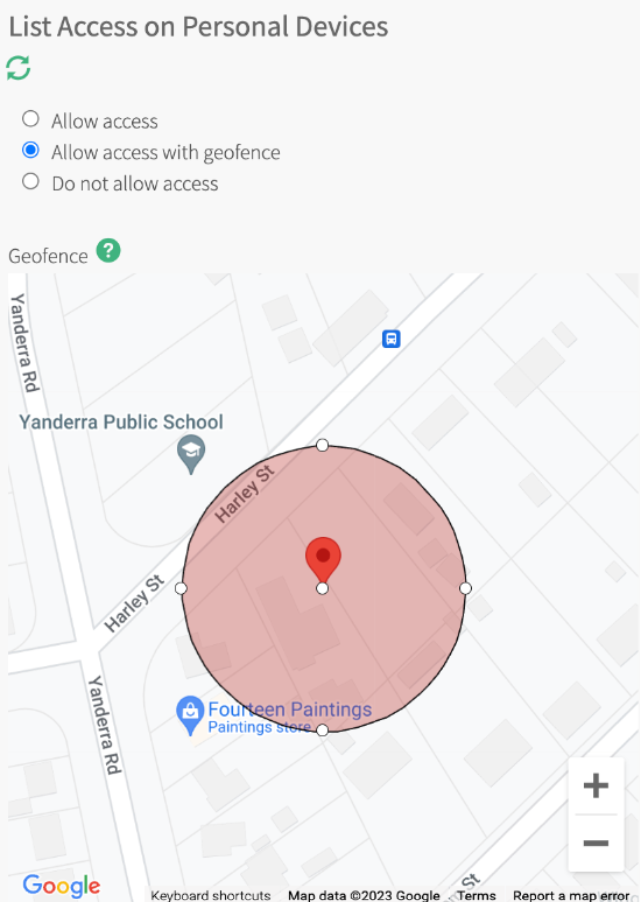
Verdict: 9/10
Time tracking features
Jolt’s time clock offers facial detection for clock-ins and clock-outs. I think this a smart way to prevent time theft—it ensures employees are physically present when logging time. There’s also PIN-based authentication as an extra security layer.
When employees forget to clock in/out, they can submit manual time entries, but these are flagged and require administrator approval, adding a layer of accountability.

Jolt handles breaks in a simple but effective way. Employees can log paid and unpaid breaks, and the system tracks total break time over a given period.
However, there are no automated break enforcement features, meaning it’s up to employees to take breaks as scheduled. If someone forgets, there are no automatic reminders or penalties, which could lead to compliance issues.
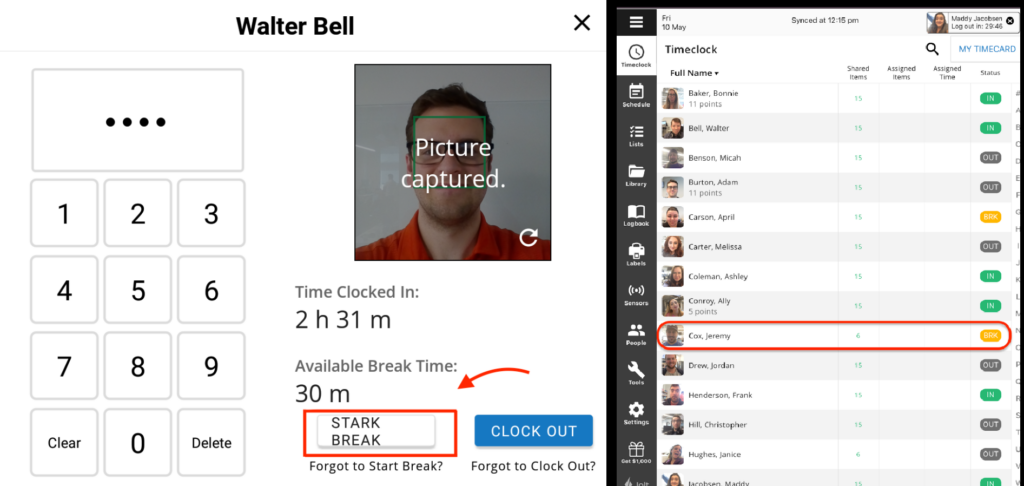
The admin oversight tools work well. Device admins can clock in or out for employees when needed, and the web portal offers clear views of timecard data.
GPS tracking exists, but not in real time—location stamps are captured at clock-in and clock-out. Unlike Connecteam, Jolt doesn’t offer live location tracking for mobile workers, which could be a dealbreaker for teams needing to monitor movement throughout the day.
Finally, Jolt tracks overtime and allows administrators to view regular, standard overtime, and total hours for each pay period through the Time Clock Report. However, it lacks advanced overtime management features, such as customizable overtime rules and alerts when employees reach overtime—something overtime management apps like Connecteam offer.
Verdict: 6/10
Scheduling and time off management
The web portal’s schedule builder is straightforward—I liked the intuitive drag-and-drop interface for easily creating and adjusting shifts.
The system starts with role configuration, where you assign and color-code employee roles for better visual organization.
I also appreciate the shift template tool. You can save entire weekly schedules as templates and apply them to future weeks, either merging them with existing shifts or replacing those existing shifts.
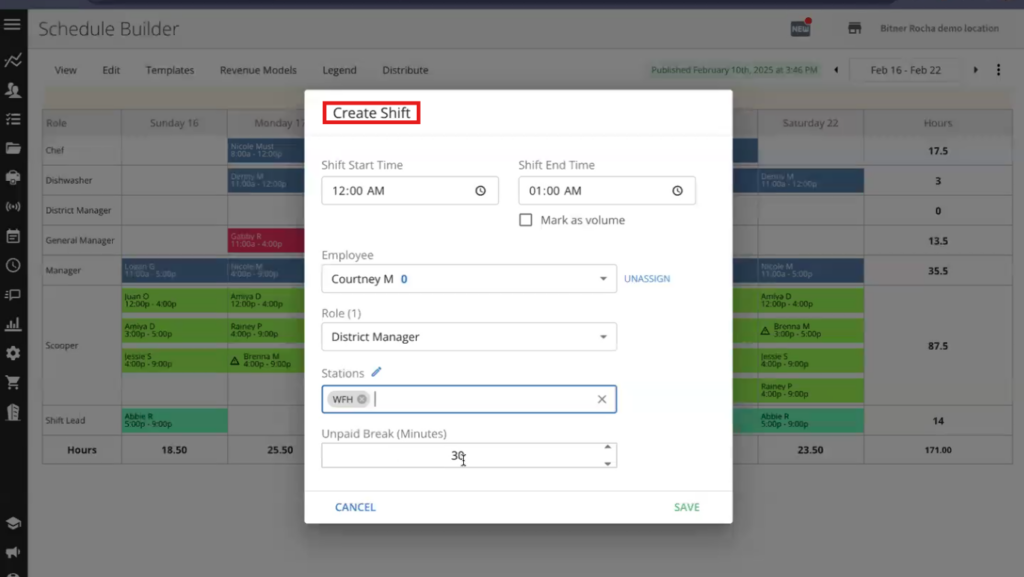
Employee availability management is well thought out. Staff can set recurring availability preferences, along with 1-time exceptions through time off requests. Plus, Jolt lets you create open shifts for employees to claim, and staff can also trade or pick up each other’s shifts.
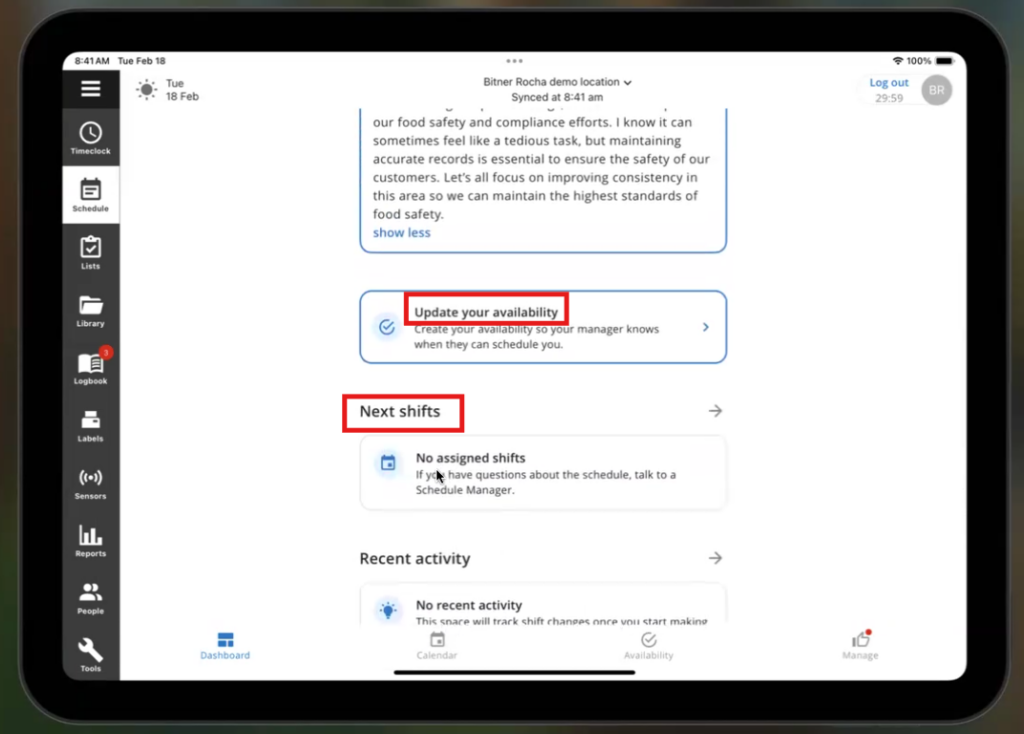
However, unlike modern alternatives like Connecteam, Jolt doesn’t offer auto-scheduling capabilities for auto-filling shifts based on availability, labor costs, or past scheduling patterns, which many competitors now offer. Schedules must be built manually or copied from templates, which can be time-consuming for businesses with frequently changing schedules.
Customizability might also be an issue, as one reviewer said, “I wish we could customize our scheduling platform more to cater to our business.”
That said, the time-off request system seems to work as expected. Employees submit their time off requests through the web or mobile app, and managers can easily review and manage requests.
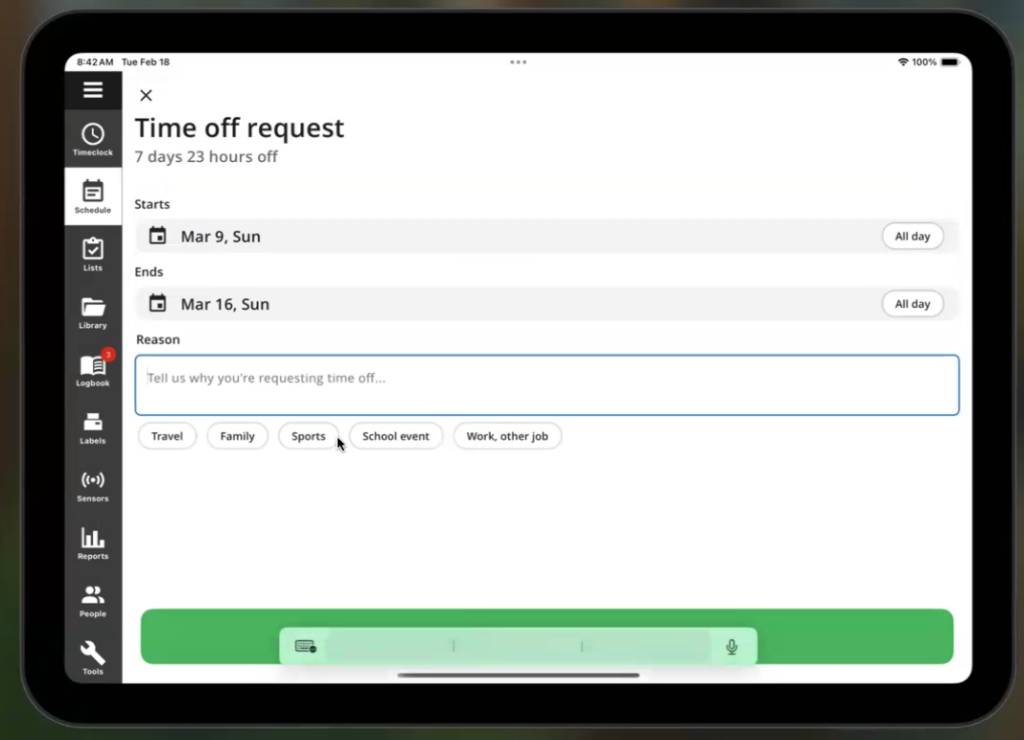
Verdict: 8/10
Communications features
Jolt offers 2 main ways to reach your team: message blasts and announcements.
Message blasts work through a simple interface in the web portal. I like that you can target specific people, roles, or entire locations, and send messages through both SMS and email. However, employees can’t reply, making it a 1-way communication tool.

The announcement feature has a clever twist. You can require employees to interact with announcements before they clock in. I think this would be useful for pushing out important operational changes or training materials, especially since you can include videos and add verification questions.
But here’s where things get limiting. There’s no real-time chat—no direct messaging between individual team members or groups. Competitors like Connecteam offer this, and it’s great for discussing shift handovers, scheduling issues, and more.
Verdict: 6/10
Jolt hardware: Sensors & labels
Jolt’s hardware centers on temperature sensors and a labeling system, both tailored for food service operations. The temperature sensors automatically track and log temperature and humidity, with real-time alerts to prevent food waste. The setup is simple, and the compact design stays out of the way.
The labeling system integrates smoothly with Jolt’s software, allowing quick printing of date labels and ingredient tags. The labels hold up well against moisture and heat, while inkless printing keeps costs low.
Jolt also provides tablets and a central hub to connect everything, syncing data and managing operations. While the system is efficient, hardware costs can add up.
Verdict: 9/10
Jolt’s integrations
Jolt primarily offers basic data exports rather than full integrations. You can export time and attendance data for payroll, but there are no direct connections with major payroll providers like ADP or QuickBooks. Compared with competitors, this feels restrictive.
Jolt does have an API, but its scope seems limited, prioritizing its own hardware ecosystem (e.g., temperature sensors, label printers) over third-party software.
For businesses using multiple platforms, this means more manual work—exporting and importing data instead of enjoying seamless automation.
Verdict: 5/10
Jolt Security Features
Jolt is compliant with the EU’s General Data Protection Regulation (GDPR). Its compliance efforts include secure data hosting, encryption, and regular audits to protect personal data and maintain privacy standards.
The platform uses TLS encryption for all data in transit and storage, and the role-based access control system lets admins set precise permissions at both location and content group levels.
Plus, it maintains SOC 2 Type II compliance. Two-factor authentication is available but—oddly—isn’t turned on by default.
Jolt claims to be compliant with the Health Insurance Portability and Accountability Act (HIPAA). But the terms of use advise against storing protected health information (PHI) on the app. This confused me, especially since other HIPAA-compliant apps like Connecteam make customers feel confident about storing patient and other protected data in their systems.
Verdict: 8/10
Jolt Reporting & Analytics
Jolt’s reporting system focuses heavily on operational compliance rather than comprehensive business analytics. The system excels at tracking metrics that matter during health inspections or audits.

Here are the key reports I found most useful:
- Temperature Monitoring: Tracks sensor readings and violation alerts with correction records.
- Task Completion: Shows checklist completion rates broken down by employee, role, and location.
- Labor Cost: Combines time clock data with wages to show spending patterns.
- Training Compliance: Displays who’s completed required training and certifications.
- Announcement Tracking: Records which employees have seen and responded to key communications.
- Food Label Compliance: Monitors labeling practices and expiration date adherence.
You can export reports in CSV and PDF formats. I appreciated the ability to schedule automated reports—it’s handy for managers who need regular metrics.
But there are some gaps. Unlike some competitors, Jolt doesn’t offer advanced forecasting or AI-driven insights. I also missed having customizable dashboards. While you can filter existing reports, creating truly custom ones means exporting data to work with elsewhere.
Verdict: 6/10
Jolt Customer Support
Jolt offers 24/7 customer support via phone, email, live chat, and a detailed knowledge base.
Users generally find the support team friendly, knowledgeable, and responsive. One user said, “Onboarding support was fantastic. My questions were answered quickly, and solutions implemented in real time.”
My experience was smooth. After filling out the demo form, I received a short but effective assessment survey. My answers helped the Jolt team tailor the presentation to my needs—something I haven’t seen with other software.
The AI chatbot, TODD, quickly directed me to relevant help articles, but live chat is misleading—clicking “talk to a person” just creates an email ticket.
The sales and onboarding experience stood out. My demo was thorough and well-structured, with a knowledgeable rep providing practical use-case examples. The follow-up was impressive, including a recording, a customized presentation, and annotated screenshots of key features. Pricing was also clearly explained.
The biggest drawback? Support is heavily email-based. While the Jolt website claims 24/7 availability, it’s more about ticket monitoring than instant help. For urgent operational issues, response delays could be a concern.
Verdict: 7/10
What are Jolt’s Review Ratings from Review Sites?
(As of February 2025)
Capterra: 4.7/5
G2: 4.4/5
Software Advice: 4.7/5
TrustRadius: 9.6/10
GetApp: 4.7/5
Google Play Store: 3.5/5
Apple App Store: 3.7/5
Jolt App Review
I think Jolt excels in operational compliance and safety protocols, particularly with its checklist management, temperature monitoring, and labeling capabilities. This makes it particularly great for food service businesses.
However, it lacks some modern workforce management features, like advanced GPS features and auto-scheduling. And basic multi-location management, limited integrations, and dated communication tools may disappoint larger operations.
Businesses seeking more sophisticated scheduling, communication, or analytics capabilities might want to explore modern alternatives.
Connecteam: The Better Jolt Alternative
I think Connecteam consistently outperforms Jolt in key areas while offering a more modern experience.
Where Jolt focuses strictly on compliance-based tasks, Connecteam’s digital forms and checklists offer advanced features like conditional logic and custom workflows.
The employee time clock functionality shows the gap between providers—Connecteam provides real-time GPS tracking and proper geofencing, while Jolt offers only basic location stamps.

Also, while both platforms offer drag-and-drop scheduling, templates, color codes, and more, Connecteam includes auto-scheduling—a feature I find indispensable.
Connecteam’s communication hub is superior, too. Instead of Jolt’s basic messaging, you get real-time online team chat, social feeds, and rich media sharing.
Plus, Connecteam’s built-in employee training software allows you to train your staff and check their performance through quizzes. You can store training materials and other documents in the company knowledge base.

But what really sets Connecteam apart is everything else it offers. I found features that Jolt doesn’t even touch:
- Digital HR tools for onboarding and documentation
- A comprehensive company employee directory
- Employee recognition features
- Advanced analytics with custom reporting
- Solid integrations with major payroll and HR systems
For businesses looking for more than basic operations management, Connecteam offers significantly more value while providing a complete platform for managing your entire workforce.
FAQs
No, Jolt doesn’t offer a free trial. However, the Jolt team provides a demo to showcase the platform’s features and how they can benefit your business.
Jolt’s software is HIPAA compliant. However, the terms of use advise against storing PHI within the system.
